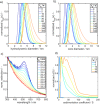Efficient quenching sheds light on early stages of gold nanoparticle formation
- PMID: 37323457
- PMCID: PMC10265400
- DOI: 10.1039/d3ra02195e
Efficient quenching sheds light on early stages of gold nanoparticle formation
Abstract
The formation mechanism of plasmonic gold nanoparticles (Au NPs) by fast NaBH4 induced reduction of the precursors is still under debate. In this work we introduce a simple method to access intermediate species of Au NPs by quenching the solid formation process at desired time periods. In this way, we take advantage of the covalent binding of glutathione on Au NPs to stop their growth. By applying a plethora of precise particle characterization techniques, we shed new light on the early stages of particle formation. The results of in situ UV/vis measurements, ex situ sedimentation coefficient analysis by analytical ultracentrifugation, size exclusion high performance liquid chromatography, electrospray ionization mass spectrometry supported by mobility classification and scanning transmission electron microscopy suggest an initial rapid formation of small non-plasmonic Au clusters with Au10 as the main species followed by their growth to plasmonic Au NPs by agglomeration. The fast reduction of gold salts by NaBH4 depends on mixing which is hard to control during the scale-up of batch processes. Thus, we transferred the Au NP synthesis to a continuous flow process with improved mixing. We observed that the mean volume particle sizes and the width of the particle size distribution decrease with increasing flow rate and thus higher energy input. Mixing- and reaction-controlled regimes are identified.
This journal is © The Royal Society of Chemistry.
Conflict of interest statement
There are no conflicts to declare.
Figures








References
-
- Moores A. Goettmann F. The plasmon band in noble metal nanoparticles: an introduction to theory and applications. New J. Chem. 2006;30:1121. doi: 10.1039/B604038C. - DOI
-
- Mukherji S. Bharti S. Shukla G. Mukherji S. Synthesis and characterization of size- and shape-controlled silver nanoparticles. Phys. Sci. Rev. 2019;4:5942.
LinkOut - more resources
Full Text Sources
Miscellaneous

